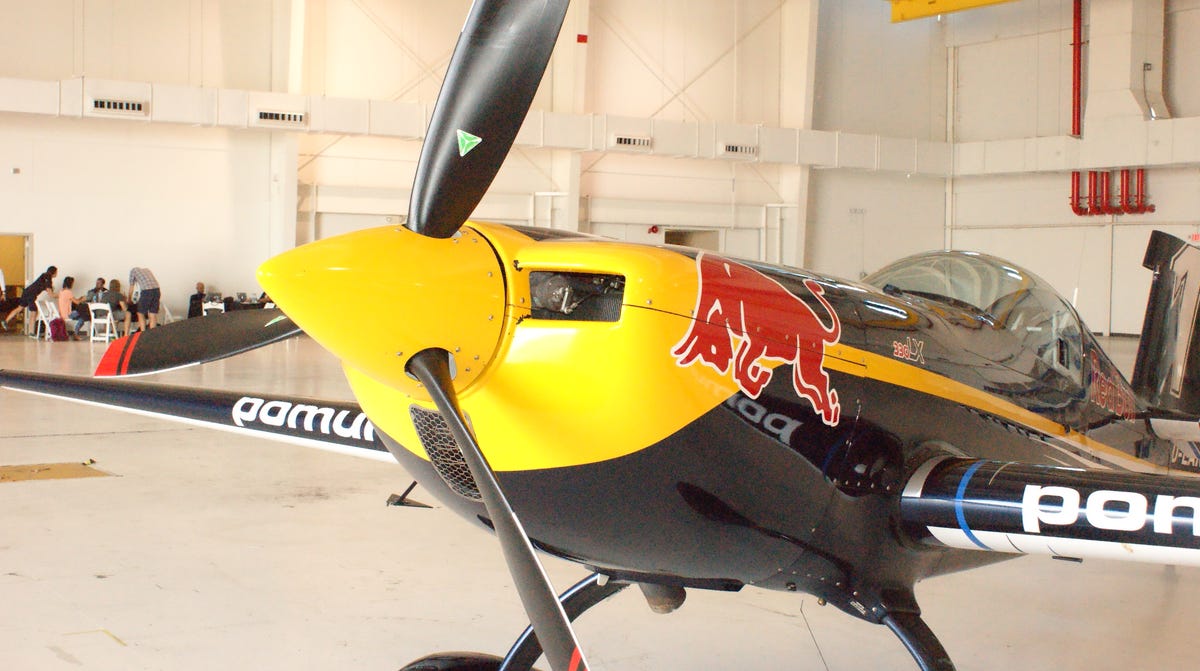A look at the tech that fuels professional air racing (pictures)
The Red Bull Air Race takes the thrill of professional racing to new heights. CNET gets up close with the racing planes in the air and on course during a stop at the Texas Motor Speedway in Fort Worth.

Acrobatic airplane
Pilots in the Red Bull Air Race, an annual series of international races, fly an Extra 330LX aircraft, a two-seat, low-wing monoplane with a top speed of 251.7 mph (219 kph) that can produce up to 10 G's of force. These planes don't just take pilots on a high-speed run. They can also pull off some impressive acrobatic maneuvers at a roll rate of 400 degrees per second.
Light and fast
Technician Niko Pueschael, pictured at the Texas Motor Speedway in Fort Worth, says the planes are made with a carbon fiber body so they're light enough to fly at high speeds. The shapes of the wings are also symmetrical "so you can fly upside down."
The races involve navigating an aerial racetrack featuring air-filled pylons. The objective is to make the best possible time -- with the least number of possible penalties. At least eight pilots compete in each Red Bull Air Race race, but only one pilot flies the course at a time.
Plane canopy
Each plane's canopy has its own unique aerodynamic design to reduce the amount of drag in mid-flight. Each plane also has an EFIS (electronic flight instrument system) that displays the plane’s speed, G-force, sector and lap times, as well as commands from the race director.
In-flight data center
The plane's EFIS also comes with a peripheral vision indicator. It can register the plane's entry speed after it passes through the first set of inflatable pylons and tell pilots how many G's they're approaching as they move across the course using a series of LED lights.
Catching it on camera
Cameras are also mounted on the tail of the plane for recording each flight for further study and sharing flight videos. A small piece of curved metal sits just above the camera that technician Niko Pueschael says can cut the inflatable pylon if it comes into contact with the tail to prevent it from getting tangled in the plane.
'It's like drugs'
Pilot Anthony Marciukaitis of Lithuania chats with US Air Force Major Tony Weedn and First Lt. Dan Gregory from the 3rd FTS Vance Air Force base located in Enid, Oklahoma, following a media flight last week. Marciukaitis says he's been flying since 1982 and competing in the Red Bull Air Race for six seasons. He says he's addicted to flying and the rush of adrenaline it gives him. "It’s like drugs. Once you start, you cannot finish."
Getting ready to fly
Annie Park of New York City gets ready to ride along on a test flight. Anyone who goes for a ride in or flies a racing plane is required to wear a seven-point seatbelt and ratchet system, a helmet, flying gloves and a parachute. All canopies can also be jettisoned in case of an emergency bailout.
Almost time to take off
Technician Raul Magan pushes a plane into place in preparation for takeoff at the Texas Motor Speedway. Each plane is powered by a custom-built six-cylinder, standardized Lycoming Thunderbolt AEIO-540-EXP engine.
Fancy propeller
Each plane is also fitted with a Hartzell three-bladed 7690 composite propeller "designed to maximize performance," according to literature released by Red Bull.
Coming in for the finish
US team pilot Kirby Chambliss races across the final pylon during a race at Texas Motor Speedway. Chambliss says he got his start in commercial aviation but later caught the bug for acrobatic flying, which led him to the Red Bull Air Race circuit.
"I'm an adrenaline junkie," Chambliss says. "I like speed, I like aerobatics, I like competition and this has got a little bit of everything all rolled into one."
Twists and turns
Kirby Chambliss, a member of the Red Bull Air Race for nine seasons who finished first in 2004 and 2006, says he uses a special piece of software under development from Microsoft that can plot the course and show him the fastest routes and how many G's he needs to pull to achieve the fastest race time.
"It's something they're trying to develop for me," Chambliss says. "It predicts instead of us trying to go out and figure what's the fastest. If you think about it, it's different from having a piece of pavement that's the same for everyone. The line's up to you. You've got to get from this gate to gate but the line's up to you. It's really become more tech on that part of it."
Getting a software boost
Mike Zyskowski, an engineering manager at Microsoft Research, says the "machine learning" software the company's developing in conjunction with Chambliss' team "could be employed in all sorts of different consumer levels or larger transportation modes. Imagine better path planning for airline traffic or better path planning for ship traffic or even cars on roads."
The software is so early in the development stage that Zyskowski says Microsoft doesn't even have a name for it yet.
"We hope we're giving [Chambliss] some opportunity and he's definitely rising in the stands but our vision's a little bit more forward looking," Zyskowski says. "Right now, this kind of a baseline to develop our algorithms, gather our data and hopefully make some improvements but really dig in and come up with some new strategies for next year."

